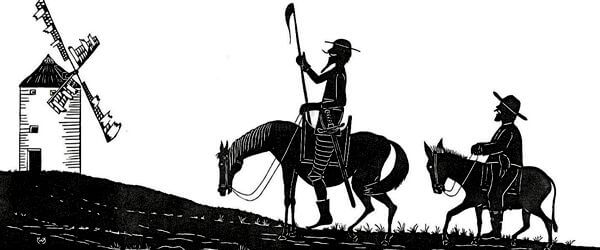
Don Quixote thought he was a leader, but other than the faithful Sancho Panza, nobody was following him.
If nobody follows you, you are not a leader.
Hat tip to Morgan DaCosta today for nudging me to a post that talks about Followership.
My definition of leadership and also the title of an earlier post:
A leader is someone others choose to follow
Now, to a post using the analogy of Don Quixote: “Don’t be more than one hilltop ahead“, an excerpt:
Don Quixote by Cervantes was one of the first great novels, published in the early 1600s.
The lead character lived a fantasy life, head in the clouds, detached from reality. Read the story and choose your own description!
He declared himself a knight, seeking chivalrous quests, often to save people from terrible fates.
Now you have a picture of this figure lost in fantasy, imagine Don Quixote on his horse, and imagining in his fantasy world he was the leader of a great army who all followed him as he leads from the front on his horse.
Though in reality his horse was constantly exhausted, he would have considered it a mighty and strong steed, and also his huge (of course!) army of foot soldiers so motivated and inspired and strong that they could keep up with him as he rode off to defeat a distant enemy army.
Irrespective of the imaginary nature of this fantasy army, Don Quixote raced off across rolling hills on his trusty steed, imagining the great victory to come. Up one hill he would go, then down another, always followed by the faithful Sancho Panza. After a time he stopped at the crest of a hill, looked back and found his army was no longer in sight. He waited, then waited some more, but they never came over the crest of the last hill into his sight.
Sancho Panza, ever the realist, would have turned to him and said something like: “Sir, you rode too fast and too far, they have lost sight of you and can no longer follow”.
You are not a leader if others aren’t following you, you are simply a fool on a horse.
Now, to a post by Fred Wilson, a leading VC for over thirty years, also someone with a wide ranging mind who blogs often. This is the post that Morgan DaCosta nudged me to read, from April this year.
Originally published here
Followership
In evaluating leaders, at the top of a company, or in the ranks of company leadership, an important quality that I look for is followership. Specifically, will the team line up behind this person?
Of course, leaders have to have other qualities. They need to have domain expertise if they are leading a specific function, they need to understand the needs of the business and the sector that it is operating in, and many other things too.
But what I have learned is that followership is super important. If the team doesn’t line up behind a leader, it is extremely hard for them to be effective.
For internal promotions, it is relatively easy to see followership and promote people who have it. You can also help people develop the management skills (listening, communicating, etc) that lead to strong followership.
When hiring someone from the outside, determining if they will have followership is harder. You can reference for this quality. But to some extent followership is a function of the culture of the organization. Someone who had strong followership in one kind of organization may not find it in another one.
It can take a leader some time to develop followership, particularly if they are hired from the outside. The team will need some time to figure out this new person, how they operate, and how they feel about them. But if a new leader has not developed the followership they need to lead the organization, or a part of the organization, within six to nine months after joining, then it is likely that a change will need to be made.
When developing your own organization and internal leaders, you should be very specific about followership and the need to develop it on your team. You should help mentor and coach younger managers on how to develop it and you should move quickly on leaders who don’t have it and won’t develop it on their teams.
It is always so impressive to me to see what leaders with strong followership can accomplish, when everyone is lined up behind them and delivering on what they ask of the organization. That is what I would wish for every organization, but sadly many don’t have it and they underperform as a result.
